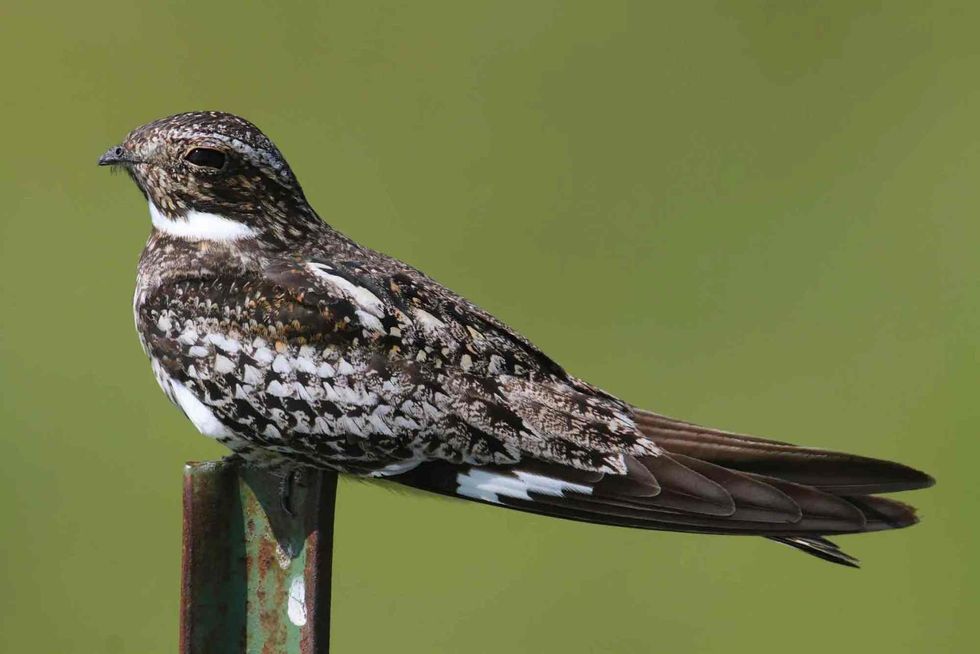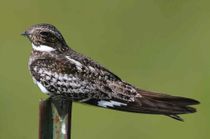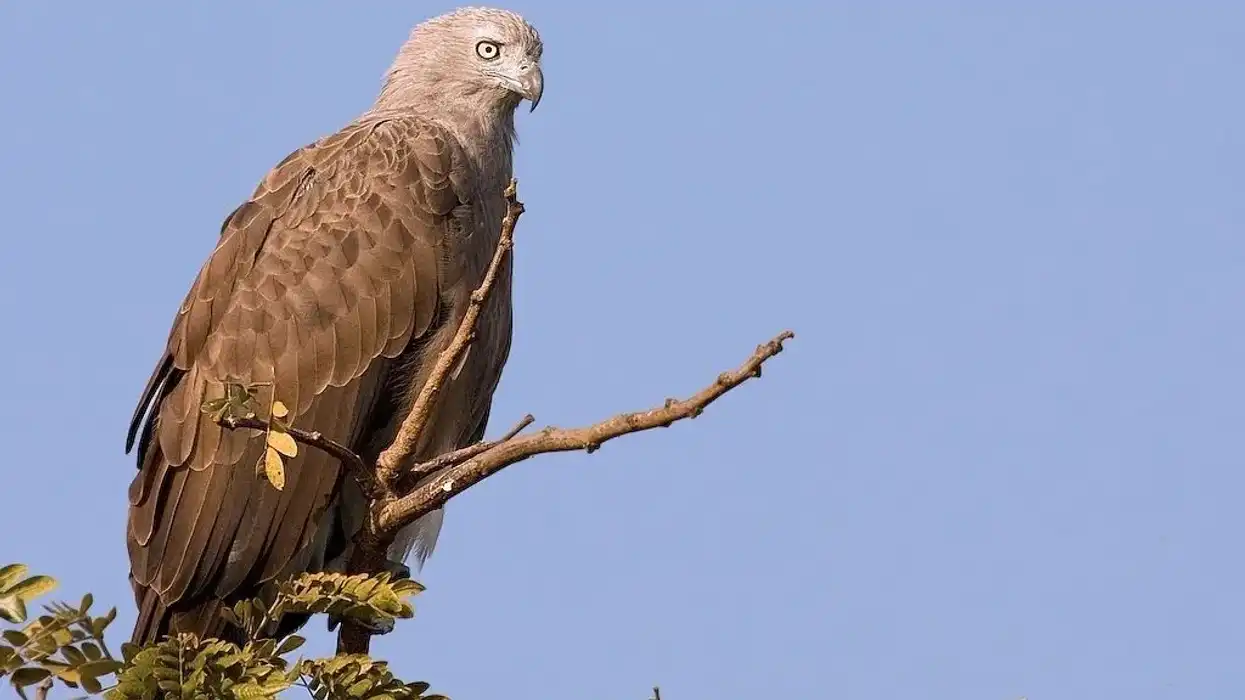The Common Nighthawk is a greyish black bird with white patches on its feathers from the 'Caprimulgidae' family with Chordeiles minor's scientific name. They are very cute, oval-shaped birds usually found in Coastal and grassy dunes, beaches, grasslands, woodland clearings, savannas, open forests, and sagebrush plains.
They are also found in open forest areas of North America, Iceland, the Azores, Greenland, the Faroe Islands, and on the British Isles. They migrate according to seasons and shift to Central America during winters.
They have big heads and pointed wings, which help them with their flight. They are nocturnal as they are usually active at night and go to well-lit areas searching for food.
They prey on flying insects, including beetles, moths, grasshoppers, and many others. The female Nighthawk lays two eggs that hatch after an incubation period of 18-20 days.
The eggs are spotted and white. The young ones are known as chicks and usually take their first flight after 25-30 days. This cute, adorable bird communicates through calls and displays.
Nighthawks are well-known for making a nest on flat gravel roofs and the ground. The conservation status is least concerned and is declining due to habitat loss and forest destruction and development in urban areas.
Loved reading this? Don't forget to check out animal facts on tawny owl or eastern kingbird.
Common Nighthawk Interesting Facts
What type of animal is a Common Nighthawk?
Common Nighthawks come under the category of birds. They belong to the Caprimulgidae family and the Animalia kingdom. Common Nighthawks are North American birds that migrate towards South America during winters.
What class of animal does a Common Nighthawk belong to?
Common Nighthawks come under Aves class with the scientific name Chordeiles minor. Common Nighthawks are nocturnal birds being active at dawn and dusk. We can also assume this fact from their name 'Nighthawks'. They are North American birds and prefer migration from one place to another as per the change of seasons.
How many Common Nighthawks are there in the world?
The population of Common Nighthawks all around the world is not officially recorded. However, in Canada alone, there are more than 400,000 Common Nighthawks.
Nighthawks are mainly North American birds but are also found in Iceland, Greenland, the Azores, the Faroe Islands and are spotted multiple times on the British Isles. If you are wondering how many subspecies of Nighthawks there are, there are nine that are primarily active at night.
Where does a Common Nighthawk live?
Common Nighthawks build their nest on flat gravel roofs and usually choose shrubs, grasslands, woodland, and Savanna areas for living where they can get food easily and material for making nests. Common Nighthawks are North American birds that migrate to Central America and different islands during winters.
What is a Common Nighthawk's habitat?
Common Nighthawks have different habitats during summers and winters. They are one of the North American birds that love migration and need specific surviving temperatures for different seasons.
They are usually spotted around Coastal and grassy dunes, beaches, grasslands, woodland clearings, savannas, open forests, and sagebrush plains, and open forests in Iceland, Greenland, the Azores Faroe Islands, and multiple times on the British Isles. Most of the time, they migrate to Central America during winters.
Female Common Nighthawks usually fly in search of a place for a nest site.
They make their nests on gravel roofs. Female nighthawks construct their nests on the earth in vast areas like forest clearings, gravel bars, sand dunes near the coast, or barely vegetated grasslands.
The Common Nighthawk diet includes flying insects, including beetles, moths, grasshoppers, and many others. Since they are nocturnal, they are only active at dawn and dusk when the Nighthawks gather near the areas of bright lights at night to feed themselves and catch their prey easily.
The young ones depend on regurgitated insects. There are nine types of Nighthawks that are a very similar species.
Who do Common Nighthawks live with?
Common Nighthawks fly during day time and in the evening in groups known as kettles. They entertain themselves by making different patterns in the sky whilst flying.
They gather in flocks during migration near the lakes or other places in search of food. They live in pairs or groups and are often seen alone, sitting on the treetops or in their nests.
How long does a Common Nighthawk live?
The life span of Common Nighthawks is four to five years. Their main threats are habitat loss and agricultural development. Nighthawks' way of living and diet plays a major role in their survival. Common Nighthawk have nine similar species. The oldest known wild Common Nighthawk was nine years old.
How do they reproduce?
The season of breeding usually takes place in summer and spring. The Common Nighthawk displays themselves by performing during flight or on the earth.
Males can fly up to five to 30 metres in the atmosphere and immediately take a fast dive back towards the earth and pull themselves above the earth at nearly two meters. The famous air rushing Common Nighthawk sound made when they dive back with their pointed wings is called 'booming sound'.
The males then approach the female, disperse and shake their tails off the edge. They, then, display their white patches on the throat while making a hoarse noise. Female nighthawks arrive early in the breeding site and search for the nesting site near bright lights on gravel roofs or bare rock.
These species breed once a year. Females lay two eggs and have an incubation period of around 20 days.
The female feeds them regurgitated insects before sunrise and after sunset. After the period of 25-30 days, the chicks leave their nest and take their first-ever flight.
What is their conservation status?
Common Nighthawk Chordeiles minor are declining. According to IUCN red list, nighthawks comes under the category of Least Concerned, and according to the UN migratory bird act, they are protected.
Due to the use of pesticides and other chemical substances, the population of nighthawks is declining. Nowadays, people are converting gravel roofs into rubber roofs, which also affects them as it becomes difficult for them to find good and safe nesting sites.
Common Nighthawk Fun Facts
What do Common Nighthawks look like?
Nighthawks prefer a habitat where they can feed themselves and can feed their young ones properly. The weight of the bird is about 55-98 gm and is 22-25 cm tall.
They have an enormous mouth and big eyes with spotted patterns like their other species. Nighthawk birds are usually grey, white, buff, and black, with pointed wings and white patches on their skin and wings. They construct their nests on the earth.
Both male birds and female birds have bold barring on their chests and belly. Sometimes, the Common Nighthawk is confused with being one of the other two species, Lesser nighthawks and Antillean nighthawks.
How cute are they?
Common Nighthawks are cute birds. Their skin is a combination of black, brown, and greyish color with white patches on feathers that look beautiful during flight. These birds have a cute little chubby body when they are young.
How do they communicate?
They communicate through calls and displays. Male Common Nighthawk calls gives a nasal 'peent' to other Nighthawk for defending their territory while flying, sometimes from the perch or the ground.
They usually communicate more at night to feed themselves and call each other in search of food. They also communicate through their displays of affection while breeding and during migration.
How big is a Common Nighthawk?
Nighthawks are 8.7-9.4 in (22-24 cm) in length with a wingspan of 20.9-22.4 in (53-57 cm) and weigh around 2.3-3.5 oz (65-98 g). They are comparatively 2-3 times bigger than Lesser Nighthawks.
How fast can a Common Nighthawk fly?
A Common Nighthawk in flight can fly up to speeds of about 23.4 km/h. They migrate to Central America during winters and need to fly over many regions. Speed is also essential for protecting themselves from predators.
How much does a Common Nighthawk weigh?
The adult bird weighs around 65-98 gm (2.3-3.5 oz)
What are their male and female names of the species?
The male bird is known as the male Common Nighthawk, and the female bird is known as the female Common Nighthawk. They do not have gender-specific names.
What would you call a baby Common Nighthawk?
The babies of Common Nighthawks are called chicks. There is no specific name for babies. The average time of hatching (eggs hatched) is 19 days, and after 25-30 days, they start flying, and in 45-50 days, they become ready for taking flight and protecting their territories.
What do they eat?
They prey on flying insects, including beetles, moths, grasshoppers, and many others.
Are they dangerous?
Nighthawks are not dangerous to human beings. They are extremely friendly birds usually living in moderate temperatures. Nighthawks are declining due to habitat loss and agricultural developments.
Would they make a good pet?
They could be good pets, but their habitat and diet does not suit humans, and it will difficult for them to survive in a human habitat. They are carnivores and eat insects and make their own nest for living on earth.
Did you know...
One of the Cornell Common Nighthawk fun facts is that they perform and display graceful dances to female nighthawks during the season of breeding, making the Common Nighthawk call which is known as a 'booming sound' while diving back toward the ground.
Although the Common Nighthawks have the word 'hawk' in their name, they aren't related to hawks. They actually belong to the Nightjar family of birds.
Common Nighthawks have tiny beaks, but they keep their mouths wide open to catch insects while they are flying.
Are Common Nighthawks nocturnal?
Nighthawks are nocturnal, meaning they are more active during nighttime and sleep in their particular preach during daytime. They fly in the morning and evening in groups making different patterns in the sky. After Sundown, they make a group move toward bright lights for catching flying small insects and other small animals.
The Common Nighthawk's call
Nasal peent or beer call is the standard call they use while flying. Females give a hissing or throaty cluck while defending their preach from the predators and defending their territories. Courting males give a croaking 'auk auk auk' call.
Here at Kidadl, we have carefully created lots of interesting family-friendly animal facts for everyone to discover! Learn more about some other birds, including frigate, or hawk.
You can even occupy yourself at home by drawing one on our Common Nighthawk coloring pages.










